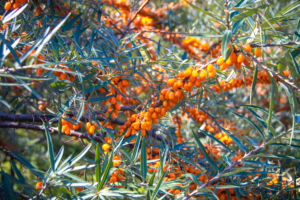Seabuckthorn provides high protection against hypoxia-induced pulmonary vascular leakage. Due to its antioxidant, antibacterial activities as well as cytoprotective, hepatoprotective, antihypertensive and wound-healing activity, seabuckthorn has been used for treating diseases in Chinese traditional medicines for a long time. Total flavonoids of seabuckthorn contain 12 compounds, including quercetin 3-O-glucoside, isorhamnetin 3-O-rutinoside, quercetin, kaempferol, isorhamnetin. These major constituents are responsible for most of the bioactive properties of seabuckthorn. Our recent study showed that quercetin had protective potential on hypobaric hypoxia-induced damage through its regulation of cardiac function, arterial blood gases, antioxidants and nitric oxide metabolism.
Seabuckthorn has been used to treat high altitude diseases. Total flavonoids of sea buckthorn decreased red blood cell number, hemoglobin, hematocrit, mean corpuscular hemoglobin levels, span of red blood cell electrophoretic mobility, aggregation index of red blood cell, plasma viscosity, whole blood viscosity, and increased deformation index of red blood cell, erythropoietin level in serum.
These flavonoids increased pH, pO2, SpO2, pCO2 levels in arterial blood, and increased Na+, HCO3−, Cl−, but decreased K+ concentrations. They increased mean arterial pressure, left ventricular systolic pressure, end-diastolic pressure, maximal rate of rise and decrease, decreased heart rate and protected right ventricle morphology. Changes in hemodynamic, hematologic parameters, and erythropoietin content indicate that oral supplementation of total flavonoids from seabuckthorn is helpful in preventing high altitude polycythaemia.
The treatment with total flavonoids of seabuckthorn improved hemodynamic, hematologic parameters, and erythropoietin content, which indicates that it helps preventing cobalt chloride- and hypobaric chamber-induced high-altitude polycythemia. Total flavonoids of sea buckthorn improved hematologic parameters which may result in reducing erythropoiesis and a minimization of the changes in the right heart.
The major constituents of total flavonoids of seabuckthorn are quercetin, isorhamnetin, and kaempferol. Quercetin has significant antioxidant activity with broad uses, and quercetin has potential protection on hypobaric hypoxia-induced damage, it is responsible for the preventive effect of total flavonoids on high-altitude polycythemia.
Our results show that total flavonoids decreased RBC, hemoglobin, hematocrit, mean corpuscular hemoglobin levels, span of RBC electrophoretic mobility, aggregation index of RBC, plasma viscosity, whole blood viscosity, and increased deformation index of RBC. In patients with chronic mountain sickness, accentuated hypoxemia is believed to result from hypoventilation, even though hypoventilation has not been observed consistently. Impaired pulmonary gas exchange is found in patients with chronic mountain sickness and must contribute to systemic arterial hypoxemia. Accentuated hypoxemia during hypoxic exposure also resulted from abnormal gas exchange.
Total flavonoids of sea buckthorn also increased pH, pO2, SpO2, and pCO2 levels in arterial blood. pCO2 fell in response to hypoxic exposure to comparable levels, indicative of a comparable alveolar hyperventilation. Suppression of the development of pulmonary hypertension during hypoxic exposure was related with an increased pO2 and an attenuated polycythemic response without any change in ventilation. High-altitude polycythemia increased blood K+ concentration, but decreased Na+, HCO3−, Cl− concentrations and pH. Total flavonoids of sea buckthorn prevented these hypoxia- and cobalt chloride-induced changes of blood electrolytes. High-altitude exposure and chronic hypoxia can lead to blood electrolytes disturbance.
Our results also show that total flavonoids of sea buckthorn decreased serum erythropoietin level in high-altitude polycythemia patients. Accordingly, hypoxia stimulates erythropoietin production and erythropoiesis; the resulting polycythemia increases the O2-carrying capacity and O2 content of blood, and this improves tissue oxygenation and turns off further production of erythropoietin. The idea of erythropoietin-O2-carrying capacity feedback is inherent in erythropoietin dose-response curves. The typical signs of HAPC develop as follows: profound arterial hypoxemia, persistent production of erythropoietin, and then extraordinary polycythemia. The above results suggest that total flavonoids of sea buckthorn may also have beneficial effects on high-altitude related and polycythemia related diseases.

Leave A Comment